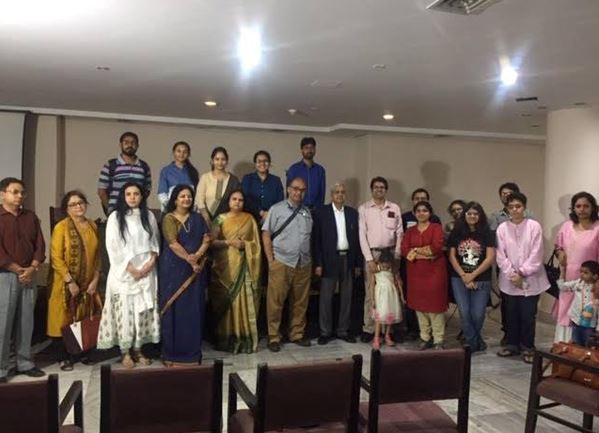
Dr Navras J. Aafreedi, an Assistant Professor in the Department of History, Presidency University, teaches several self-designed courses in Jewish studies, Genocide studies and interfaith studies and has to his credit extensive publications on Jews, Judaizing Movements and the Traditions of Israelite Descent in South Asia.Dr Aafreedi delivered a talk on The Lost Tribes of Israel and it’s Contemporary Ramifications: A Case Study of Pashtuns/Pakhtuns/Pathans at the Eastern Zonal Cultural Centre (EZCC) on Friday March 18, 2019 from 5 pm onwards.The event was organised in association with Asia in Global Affairs (AGA). The session was chaired by Sitaram Sharma, President, AGA.
Showcasing the heritage which he certainly was very proud of, Dr Aafreedi traced the ancient history of the lost tribes of Israel intertwining it with their location in the present day all over the world, marking their genetic configurations. The history of the “Lost Tribes” is fascinating.All Biblical patriarchs, revered by Jews, Christians and Muslims alike, are mythological, including Jacob (also knownas Israel), who is the supposed progenitor of the lost tribes of Israel. Scholars have contended that if ever the patriarchs existed, they were not related to each other, but were independent tribal chieftains who were united in a genealogical pattern later in history. It is indeed difficult to locate these lost tribes as they are dispersed and have assimilated into the general populations of the various regions where they have settled.Ten of the original twelve Hebrew tribes, which, under the leadership of Joshua, took possession of Canaan, the promised land, after the death of Moses, were named Asher, Dan, Ephraim, Gad, Issachar, Manasseh, Naphtali, Reuben, Simeon, and Zebulun—all descendants of Jacob. In 930 BC, the 10 tribes formed the independent Kingdom of Israel in the North and the 2 other tribes, Judah and Benjamin, set up the Kingdom of Judah in the South.Around 6,000 Bene Menashe currently reside in the Indian states of Mizoram and Manipur, along the border with Burma and Bangladesh, and Bene Ephraim in Andhra Pradesh. Bene Menashe has been recognised as a lost Israeli tribe by the Chief Rabbinate after being exiled from the Land of Israel by the Assyrian Empire in 723 BC. The community of Christians were of the belief that Jesus Christ would not come back unless the lost tribes of Israel accept him as the messiah. A prerequisite for Jesus’ return to earth is the conversion of all Jews by embracing Christianity. Similarly, it is a prerequisite for all the lost tribes to gather in Israel for the messiah to resurface. There have been Jewish Rabbis, Persian chroniclers and European adventurerswho have enthusiastically conferred the designation of the ‘Lost Tribes of Israel’ to the Pashtuns or the Pakhtuns.
Among all claimants of Israelite descent, one group that stands out is that of the Pashtuns, Pakhtuns and Pathans. These terms are often used interchangeably, however each has its own distinct meaning. These nomenclatures are umbrella terms used for the world’s largest conglomerate tribes in Eastern Pakistan and Western Afghanistan. They are not homogenous in nature. The Northern Highlanders are called the Pashtuns, the southern highlanders are known as the Pashtuns, while the plains of the Indian subcontinent are referred to by the name- Pathan. Traditionally, the term Afghan was used exclusively for Pakhtuns, Pashtuns and Pathans and with the emergence of the modern state of Afghanistan the ethnic minorities that fell within its borders were termed as Afghans, like the Tajiks, the Uzbeks and the Hazaras- the other minor ethnic groups. The Pakhtuns are the largest group in Afghanistan. A new Judaic movement has emerged among them. It is particularly from the Pashtuns that the Islamic Talibanhas emerged in Afghanistan. Although they resonate with their Israelite descent, but they seldom show signs of migrating back to the modern state of Israel. More often than not, these groups are suspected of fabricating Israelite ideologies, to make a transition to the first world country. The talk concluded with a mention of some eminent Pashtuns in the Indian context. They include Abdul Ghaffar Khan, the foremost 20th-century leader of the Pashtuns, who became a follower of Mahatma Gandhi and was popularly called the ‘Frontier Gandhi’. Dr Zakir Hussain, the third President of India was a Pathan, who hailed from Farrukhabad.He was also the founder of Jamia Millia Islamia University, Delhi. Shahnaz Ali, a Mumbai-based researcher from the National Institute of Immunohematology, had collected DNA samples from members of the Afridi tribe of the Pashtuns, who can be traced to Malihabad, near Lucknow.
An enlightening, insightful and knowledgeable talk was followed by a question-answer session.
Mahima Maniar
Intern, AGA


